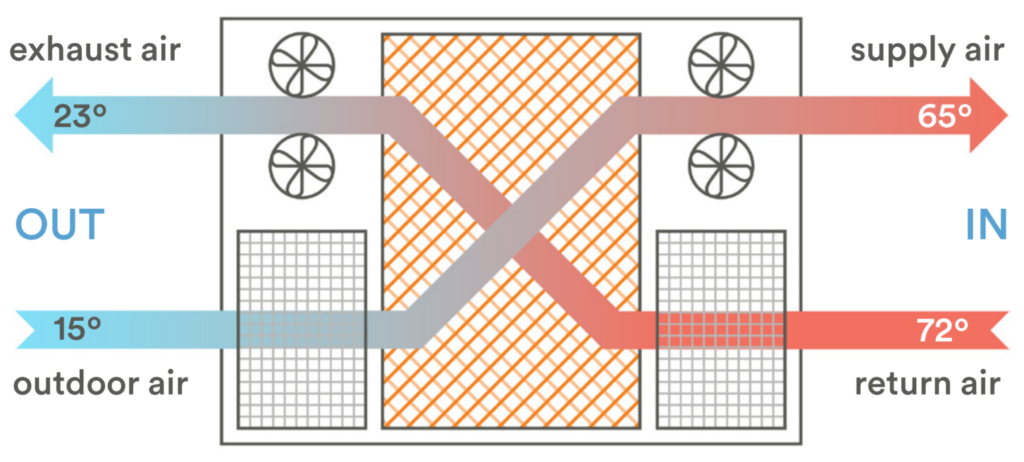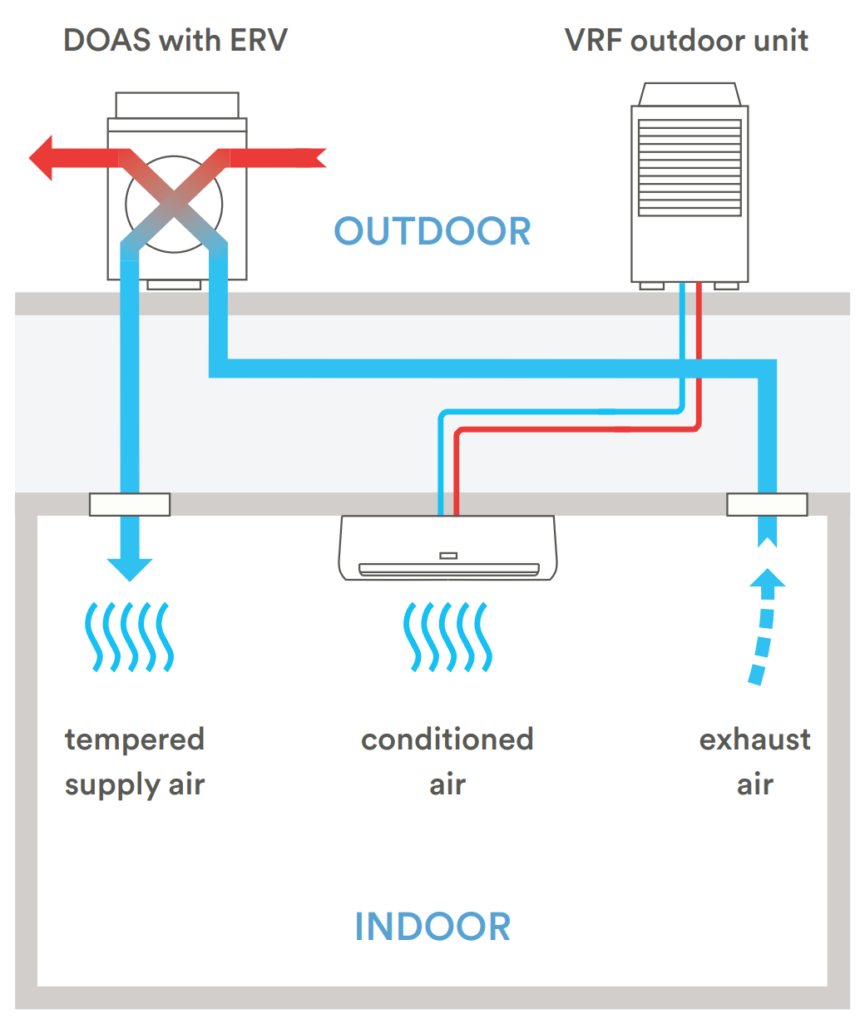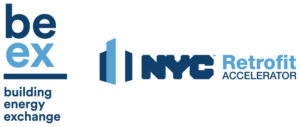Dedicated Outdoor Air Systems (DOAS) with Energy Recovery Ventilators (ERV)
Controlled ventilation for enhanced comfort and savings.
Tech Overview
Applicable Buildings Types commercial
When to Implement anytime, at time of midcycle or refinance
*Be sure to consult a qualified service provider to determine the right measures for your building.
What is a Dedicated Outdoor System with Energy Recovery Ventilators?
All commercial buildings in the US are required to supply fresh air to occupied spaces. A Dedicated Outdoor Air System (DOAS) with a high efficiency Energy Recovery Ventilator (ERV) is an alternative ventilation system design that can significantly reduce a building’s heating and cooling loads and provide controlled and conditioned ventilation that improves indoor air quality and occupant health, while reducing GHG emissions and saving energy.

Fig 1. During winter, heat from the return air is transferred to the supply air in the heat recovery core (orange hatch) of an ERV. The flow of heat reverses in summer, where heat from the outdoor air is transferred to the exhaust air, helping to cool the supply air.

Fig 2. When paired with a VRF heating and cooling system, a DOAS with ERV creates a complete HVAC solution. In cooling mode, for instance, the ERV uses the exhaust air to transfer heat from the outdoor air, tempering the supply air to the building. The VRF does less work because the supply air temperature from the DOAS is closer to the desired indoor temperature.
How to Implement
A DOAS and ERV system combined with a properly downsized heating and cooling system and programs HVAC controls will generate significant energy savings. Coordinate heating and cooling retrofits in order to size equipment based on these load reductions. Download the full tech primer to learn more about each of the following steps:
A. Install a DOAS and an ERV at the highest efficiency available. The ERV should be sized to operate at 40%-60% of its rated capacity during design conditions
B. Install a Ductless Heating and Cooling System to pair with a DOAS and ERV system creates a complete, high performance HVAC solution (see Fig 2)
C. Upgrade Controls to further optimization of the building’s HVAC system by programmed heating, cooling,and ventilation controls based on demand, measured CO2 levels, or an occupancy schedule
Cost and Benefits
Cost and benefits of a Dedicated Outdoor Air System (DOAS) with Energy Recovery Ventilators (ERV) will vary depending on your building’s baseline systems and conditions. Typically, buildings can expect to see the following results:
Greenhouse Gas (GHG) Savings
In a DOAS with ERV system, almost all of the energy in exhausted air can be recovered by the incoming fresh air (or vise versa), dramatically lowering heating and cooling loads and related GHG emissions.
Tenant Experience Improvement
A DOAS installation dramatically improves tenant satisfaction by reducing temperature extremes and improved indoor air quality.
Utility Savings
Although a DOAS with ERV significantly reduces heating and cooling loads, electricity is a significantly more expensive form of energy than natural gas, fuel oil, or district steam.
Capital Cost
A DOAS installation requires a very high capital investment, although actual installation cost will depend on the building’s existing conditions.
Maintenance Requirement
A DOAS and ERV system requires a low level of maintenance thanks to ERV dirty filter detectors.
Take Action
This information is part of more than a dozen High Performance Technology Primers prepared by the Building Energy Exchange and the Retrofit Accelerator to introduce decision-makers to solutions that can help them save energy and improve comfort in their buildings. Curious about other retrofitting possibilities? Explore our complete library of Tech Primers here.
The NYC Retrofit Accelerator’s team of Efficiency Advisors offers free, personalized advisory services to help streamline the process of making energy efficient improvements to your buildings.
Get in touch with the NYC Retrofit Accelerator today!
Call (212) 656-9202
Visit nyc.gov/RetrofitAccelerator
Email info @nycretrofit.org
